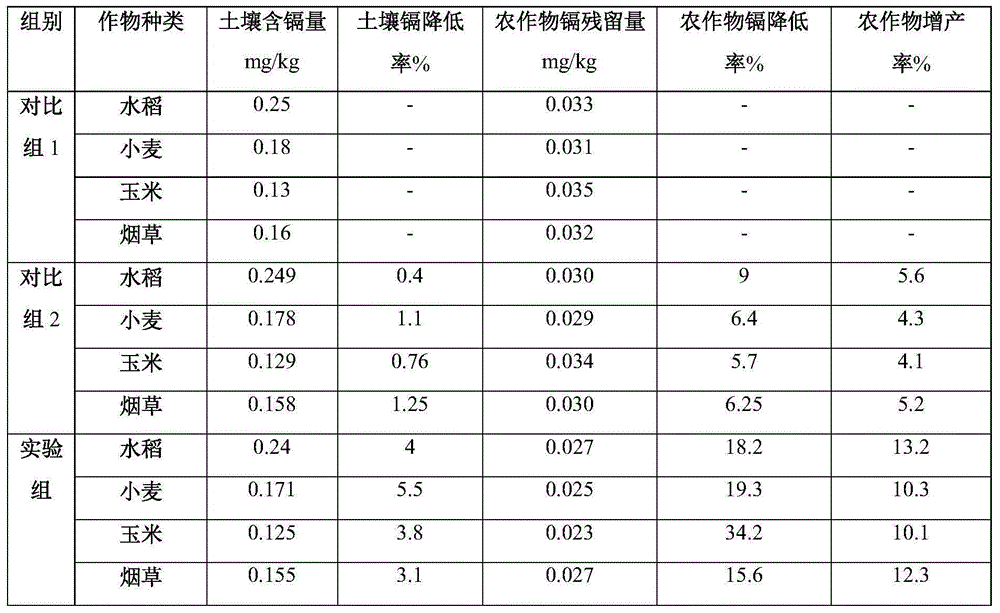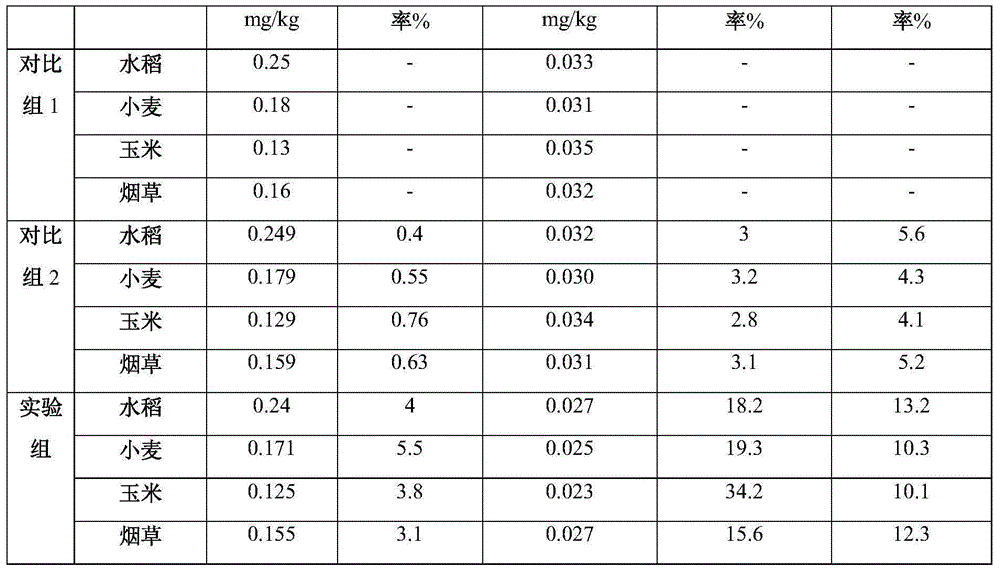Method for reducing content of cadmium in crops
A crop and content technology, applied in fertilization methods, soil preparation methods, agriculture, etc., can solve the problems of destroying soil structure, harming healthy life, affecting crop yield, etc., and achieve the effect of enhancing dissolution, promoting absorption, and promoting the formation of soil structure
- Summary
- Abstract
- Description
- Claims
- Application Information
AI Technical Summary
Problems solved by technology
Method used
Image
Examples
Embodiment 1
[0025] Test site: Beihai Suburban Vegetable Planting Base
[0026] Test crops: rice, wheat, corn, tobacco
[0027] Field test design: the spraying object of the control group 1 is clear water, the spraying object of the control group 2 is spraying common water-soluble fertilizer, and the spraying object of the experimental group is the organic water-soluble fertilizer provided by the present invention: plant source organic matter 20, humus Acid 12, citric acid 2, amino acid 8, vitamin 8, monosaccharide 8, polysaccharide 8, potassium sodium tartrate 1, ethylene glycol 3, nacre powder 5, ceramsite 3, zinc sulfate 1, manganese sulfate 1, boric acid 1, Ammonium molybdate 8, urea 8, potassium dihydrogen phosphate 8 and phosphoric acid 8. According to the crops to be tested, 4 plots were divided, each plot was 66.6m2, and the interval between the plots and the plots was 3m, arranged randomly, and the experiment was repeated 3 times.
[0028] Each group in this test all adopts fert...
Embodiment 2
[0033] Test site: Beihai Suburban Vegetable Planting Base
[0034] Test crops: rice, wheat, corn, tobacco
[0035] Field test design: control group 1 sprayed with clear water, control group 2 sprayed with common water-soluble fertilizer, and experimental group sprayed with organic water-soluble fertilizer provided by the present invention: plant source organic matter 20, humic acid 12, citric acid 2, amino acid 8, vitamins 8. Monosaccharide 8, polysaccharide 8, potassium sodium tartrate 1, ethylene glycol 3, nacre powder 5, ceramsite 3, zinc sulfate 1, manganese sulfate 1, boric acid 1, ammonium molybdate 8, urea 8, dihydrogen phosphate Potassium 8 and Phosphate 8. According to the crops to be tested, 4 plots were divided, each plot was 66.6m2, and the interval between the plots and the plots was 3m, arranged randomly, and the experiment was repeated 3 times.
[0036] Control group 1 and control group 2 adopt common fertilization method;
[0037] Experimental group adopts f...
Embodiment 3
[0042] Test site: Beihai Suburban Vegetable Planting Base
[0043] Test crops: rice, wheat, corn, tobacco
[0044] Field test design: control group 1 was sprayed with clear water, control group 2 was sprayed with ordinary water-soluble fertilizer, and the experimental group was sprayed with organic water-soluble fertilizer provided by the present invention: plant source organic matter 22, humic acid 15, citric acid 2, amino acid 10, vitamins 10. Monosaccharide 10, polysaccharide 10, potassium sodium tartrate 2, ethylene glycol 5, nacre powder 5, ceramsite 5, zinc sulfate 3, manganese sulfate 1, boric acid 1, ammonium molybdate 15, urea 15, dihydrogen phosphate Potassium 15 and Phosphate 15. According to the crops to be tested, 4 plots were divided, each plot was 66.6m2, and the interval between the plots and the plots was 3m, arranged randomly, and the experiment was repeated 3 times.
[0045] Control group 1 and control group 2 adopt common fertilization method;
[0046] E...
PUM
 Login to View More
Login to View More Abstract
Description
Claims
Application Information
 Login to View More
Login to View More - R&D
- Intellectual Property
- Life Sciences
- Materials
- Tech Scout
- Unparalleled Data Quality
- Higher Quality Content
- 60% Fewer Hallucinations
Browse by: Latest US Patents, China's latest patents, Technical Efficacy Thesaurus, Application Domain, Technology Topic, Popular Technical Reports.
© 2025 PatSnap. All rights reserved.Legal|Privacy policy|Modern Slavery Act Transparency Statement|Sitemap|About US| Contact US: help@patsnap.com



